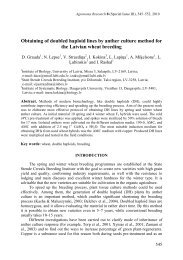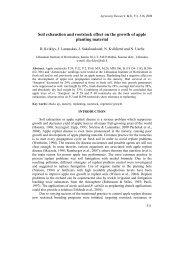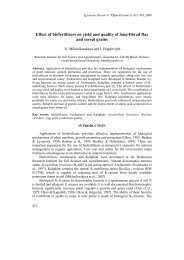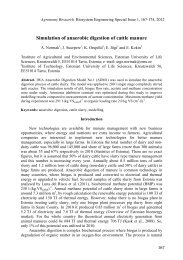Essential technical parameters for effective biogas production
Essential technical parameters for effective biogas production
Essential technical parameters for effective biogas production
Create successful ePaper yourself
Turn your PDF publications into a flip-book with our unique Google optimized e-Paper software.
Substrate dosing engine: Aside from the composition of the substrate mixture,<br />
substrate conditioning has the potential to optimize <strong>production</strong> efficiency of the entire<br />
plant (Scholwin et al, 2004).<br />
The substrate dosing engine should be tuned optimally to the used substrates to<br />
reach a good milling, particularly of fiber-rich material. Inadequate tuning can result in<br />
bridge <strong>for</strong>mations and blockages which can lead to disturbances of the dosage<br />
Continuous laboratory analysis of the substrate can often recognise changes in the<br />
process and the operator can intervene quickly. The costs <strong>for</strong> the analyses are minimal<br />
compared to those of a plant malfunction.<br />
Measuring and control technology: To achieve successful practice of a <strong>biogas</strong><br />
plant in the long term, the fermenting process must be continuously controlled so that<br />
the active micro-organism groups in the fermenter find good environmental conditions<br />
and a balance <strong>for</strong>ms in the fermenter. Only few plants are satisfactorily equipped with<br />
measuring technology <strong>for</strong> supervision of the process. But <strong>parameters</strong> such as mass of<br />
supplied substrates, fermenting temperature (Fig. 6), pH factor, dwell time, space load,<br />
<strong>biogas</strong> amount and composition, ammonium concentration and short-chained fatty<br />
acids should be controlled regularly. If the dwell time of the substrate in the fermenter<br />
is too short, methane bacteria can leach because of methane’s longer generation time.<br />
As a result of this process the dismantling speed diminishes (Grepmeier, 2002).Thus<br />
disturbances can be recognised in the fermentation process and countermeasures can be<br />
initiated. In addition, the kinds, time and frequency of the substrate input can be<br />
recorded. If a substrate dosing engine exists, the engine can weigh the substrate. If<br />
liquid components are supplied to the fermenter, the capture of this biomass occurs<br />
with the flow measuring instruments which work electronically.<br />
Fig. 6. Temperature detector.<br />
Fig. 7. Flash protection at the foil<br />
cap.<br />
Foil caps: During the operation gas mixtures capable of explosion exist in the gas<br />
space of the fermenting chamber. Sparking is to be avoided. The stirring device should<br />
be worked beneath the surface. Additionally, a flash protection device (Fig.7) should<br />
be installed close to the foil cap.<br />
345







